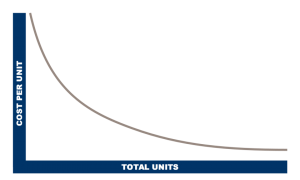The Experience Curve
Revisiting fundamental business concepts is helpful. Old concepts often have new meaning when viewed after new experiences. Or, as we say at the school where I am a co-owner, “See it with today’s eyes and hear it with today’s ears.”
One important, fundamental concept is the idea of economies of scale, or the Experience Curve, as developed by the Boston Consulting Group in 1966. As described by the Harvard Business Review, this concept captured the notion that companies develop competitive advantage by learning over time how to lower costs, gain efficiencies, and improve products by redesigning and utilizing better technology. As shown in the chart, the cost per unit goes down as the number of units goes up. Therefore, if your company is the largest producer in a given market, your company should have a persistent advantage in having lower costs per unit.
In my mind, I am trying to think about this concept in today’s world as I fight a bias that this concept was more relevant in large scale enterprises that seemed to dominate in the mid 20-th century but are not as impressive as the more efficient (capital and labor efficiency) enterprises of today. In the classic sense, economies of scale usually speak to businesses that have high up-front, fixed costs and relatively low run costs per unit. I suppose that many of the products of modern enterprises have zero marginal cost (Windows operating system, a new Google search, a new Facebook user, one more view of a movie on Netflix, etc.) but they did require large, up-front investments to build Windows, for example. Some of these more modern examples are benefiting more from network effects than from old-fashioned economies of scale.
There must still be an advantage with scale as the Fortune reported in June 2012 that for the Fortune 500 the average revenue per employee was $455,000 and the average profit per worker was $32,000 in 2011. Those are pretty strong numbers as compared to the smaller companies with which I am familiar.
Economies of Scale – Some Thoughts:
- Economies of scale in physical product production. For physical products, I do not think much has changed. Having scale is still an advantage in sourcing raw materials, developing production efficiencies, and getting financial terms from partners.
- Economies of scale in distribution of physical products. Scale is also still an advantage here. In fact, I believe that Coca-Cola’s distribution system is more of an advantage than the brand. Or, a consumer product company has an advantage if they are large enough to partner profitably and effectively with Wal-Mart and Target.
Although I do not think economies of scale is often thought about in marketing, here are some initial thoughts that came to me about economies of scale in marketing today:
- Economies of scale in general, modern marketing. If modern marketing is organic search optimization, Google Adwords, inbound marketing through content creation, managing social media, etc. then it seems that scale does not create tremendous advantages once you get large enough to do the basic work required in these channels. In businesses that utilize traditional marketing, economies of scale still create an advantage in producing TV ads, buying TV time, and more. Still, the Procter & Gamble’s of the world do not enjoy as much of a marketing advantage today because more marketing does not require large scale.
- Economies of scale in organic search optimization. To be able to dominate natural search results for important keywords is an area where scale helps. If your company is large enough or has a long enough history to have developed a web of inbound links and search engine credibility in a category, it is difficult for newcomers to displace your company once you have established that advantage. Even though search engine marketing has existed for a long time, I suspect that many people still do not appreciate the advantage that dominating natural search results can be. This is not exactly economies of scale (maybe more of a network effect) but if you are large enough to dominate a category, you are most likely to dominate those keywords.
- Economies of scale in relationship marketing or social media. I think it helps if you have a critical mass of real relationships in a field or industry as a positive reputation tends to reinforce itself among that group of people. Yet, it also seems that social media has enabled a single person to have nearly as many relationships as an entire company had previously.
Questions for you: Is there anywhere in your business where economies of scale can create an advantage for you? Are there new opportunities for you where economies of scale dominated before but now do not have as much of an advantage?



 I am an investor at Greybull Stewardship, an
I am an investor at Greybull Stewardship, an 
 Sign Up
Sign Up RSS Feed
RSS Feed
By Profitability Differences Between Industries - Some Surprises August 28, 2012 - 3:07 am
[…] Chart on Economies of Scale, August 14, 2012 […]
By Five Forces by Michael Porter -- Fundamentals Through Graphics - Mason Myers Blog February 3, 2013 - 9:02 pm
[…] Revisiting fundamental business concepts is helpful. We last did this in the post on the economies of scale and the experience curve developed by the Boston Consulting Group in […]
By Investment Wisdom Convergence from Clayton Christensen and Charlie Munger - Mason Myers Blog May 20, 2013 - 9:09 pm
[…] Experience curve and advantages of scale — please see this post and Munger makes the simple analogy that as the size of a tank increases, the steel only increases by the square but the volume increases by the cube […]
By BCG Growth Share Matrix of Cash Cows, Dogs, and Stars - Mason Myers Blog July 7, 2013 - 10:35 pm
[…] ideas, seen anew, can be helpful to business owners. In that spirit, I have highlighted Economies of Scale and Michael Porter’s Five Forces previously. Today, I highlight another older idea in the […]
By Business Decision Making, Business And Investments | Blog For Business Owners And Investors August 16, 2013 - 11:43 am
[…] Economies of Scale — Fundamentals Through Graphics [masonmyers.com Oct xx, 2012] […]